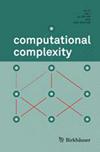计算有界信道下具有最优速率的显式列表可译码码
IF 1
3区 计算机科学
Q3 COMPUTER SCIENCE, THEORY & METHODS
引用次数: 17
摘要
随机码是一对编码和解码过程(Enc,Dec→ {0,1}n。该代码是(p,L)列表可解码的类$$\mathcal{C}$$C的“通道函数”$$C:\{0,1\}^{n}\rightarrow\{0,1 \}^{n}$C:{0,1}n→ {0,1}n如果对于每个消息$$m\in\{0,1\}^{k}$m∈{0、1}k和每个通道$$C\in\mathcal{C}$C∈C最多会引发pn错误,则在“接收字”C(Enc(m,S))上应用Dec会生成一个最多包含L个消息的列表,这些消息包含m的概率高于均匀$$S\leftarrow\{0;1}^← {0,1}d。注意,当试图解码时,信道C和解码算法Dec都不接收随机变量S。代码的速率是$$R=k/n$$R=k/n,并且如果Enc、Dec在时间poly(n)中运行,则代码是显式的。Guruswami和Smith(《ACM杂志》,2016)表明,对于每一个常数$$0本文章由计算机程序翻译,如有差异,请以英文原文为准。
Explicit List-Decodable Codes with Optimal Rate for Computationally Bounded Channels
A stochastic code is a pair of encoding and decoding procedures (Enc, Dec) where $${{\rm Enc} : \{0, 1\}^{k} \times \{0, 1\}^{d} \rightarrow \{0, 1\}^{n}}$$ Enc : { 0 , 1 } k × { 0 , 1 } d → { 0 , 1 } n . The code is ( p, L )-list decodable against a class $$\mathcal{C}$$ C of “channel functions” $$C : \{0,1\}^{n} \rightarrow \{0,1\}^{n}$$ C : { 0 , 1 } n → { 0 , 1 } n if for every message $$m \in \{0,1\}^{k}$$ m ∈ { 0 , 1 } k and every channel $$C \in \mathcal{C}$$ C ∈ C that induces at most pn errors, applying Dec on the “received word” C (Enc( m,S )) produces a list of at most L messages that contain m with high probability over the choice of uniform $$S \leftarrow \{0, 1\}^{d}$$ S ← { 0 , 1 } d . Note that both the channel C and the decoding algorithm Dec do not receive the random variable S , when attempting to decode. The rate of a code is $$R = k/n$$ R = k / n , and a code is explicit if Enc, Dec run in time poly( n ). Guruswami and Smith (Journal of the ACM, 2016) showed that for every constants $$0 < p < \frac{1}{2}, \epsilon > 0$$ 0 < p < 1 2 , ϵ > 0 and $$c > 1$$ c > 1 there exist a constant L and a Monte Carlo explicit constructions of stochastic codes with rate $$R \geq 1-H(p) - \epsilon$$ R ≥ 1 - H ( p ) - ϵ that are ( p, L )-list decodable for size $$n^c$$ n c channels. Here, Monte Carlo means that the encoding and decoding need to share a public uniformly chosen $${\rm poly}(n^c)$$ poly ( n c ) bit string Y , and the constructed stochastic code is ( p, L )-list decodable with high probability over the choice of Y . Guruswami and Smith pose an open problem to give fully explicit (that is not Monte Carlo) explicit codes with the same parameters, under hardness assumptions. In this paper, we resolve this open problem, using a minimal assumption: the existence of poly-time computable pseudorandom generators for small circuits, which follows from standard complexity assumptions by Impagliazzo and Wigderson (STOC 97). Guruswami and Smith also asked to give a fully explicit unconditional constructions with the same parameters against $$O(\log n)$$ O ( log n ) -space online channels. (These are channels that have space $$O(\log n)$$ O ( log n ) and are allowed to read the input codeword in one pass.) We also resolve this open problem. Finally, we consider a tighter notion of explicitness, in which the running time of encoding and list-decoding algorithms does not increase, when increasing the complexity of the channel. We give explicit constructions (with rate approaching $$1 - H(p)$$ 1 - H ( p ) for every $$p \leq p_{0}$$ p ≤ p 0 for some $$p_{0} >0$$ p 0 > 0 ) for channels that are circuits of size $$2^{n^{\Omega(1/d)}}$$ 2 n Ω ( 1 / d ) and depth d . Here, the running time of encoding and decoding is a polynomial that does not depend on the depth of the circuit. Our approach builds on the machinery developed by Guruswami and Smith, replacing some probabilistic arguments with explicit constructions. We also present a simplified and general approach that makes the reductions in the proof more efficient, so that we can handle weak classes of channels.
求助全文
通过发布文献求助,成功后即可免费获取论文全文。
去求助
来源期刊

Computational Complexity
数学-计算机:理论方法
CiteScore
1.50
自引率
0.00%
发文量
16
审稿时长
>12 weeks
期刊介绍:
computational complexity presents outstanding research in computational complexity. Its subject is at the interface between mathematics and theoretical computer science, with a clear mathematical profile and strictly mathematical format.
The central topics are:
Models of computation, complexity bounds (with particular emphasis on lower bounds), complexity classes, trade-off results
for sequential and parallel computation
for "general" (Boolean) and "structured" computation (e.g. decision trees, arithmetic circuits)
for deterministic, probabilistic, and nondeterministic computation
worst case and average case
Specific areas of concentration include:
Structure of complexity classes (reductions, relativization questions, degrees, derandomization)
Algebraic complexity (bilinear complexity, computations for polynomials, groups, algebras, and representations)
Interactive proofs, pseudorandom generation, and randomness extraction
Complexity issues in:
crytography
learning theory
number theory
logic (complexity of logical theories, cost of decision procedures)
combinatorial optimization and approximate Solutions
distributed computing
property testing.
 求助内容:
求助内容: 应助结果提醒方式:
应助结果提醒方式:


